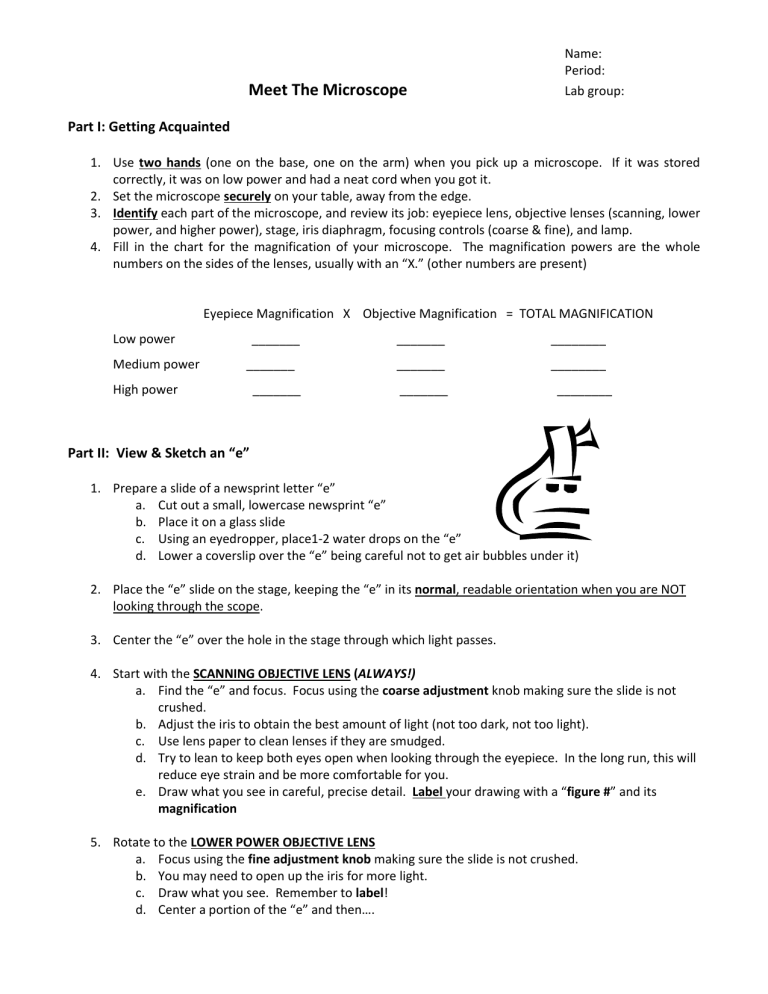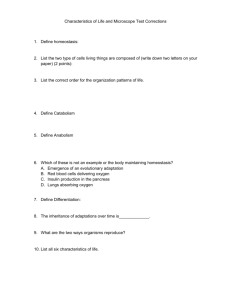Meet The Microscope

Name:
Period:
Meet The Microscope
Lab group:
Part I: Getting Acquainted
1.
Use two hands (one on the base, one on the arm) when you pick up a microscope. If it was stored correctly, it was on low power and had a neat cord when you got it.
2.
Set the microscope securely on your table, away from the edge.
3.
Identify each part of the microscope, and review its job: eyepiece lens, objective lenses (scanning, lower power, and higher power), stage, iris diaphragm, focusing controls (coarse & fine), and lamp.
4.
Fill in the chart for the magnification of your microscope. The magnification powers are the whole numbers on the sides of the lenses, usually with an “X.” (other numbers are present)
Eyepiece Magnification X Objective Magnification = TOTAL MAGNIFICATION
Low power _______
Medium power _______
High power _______
_______
_______
_______
________
________
________
Part II: View & Sketch an “e”
1.
Prepare a slide of a newsprint letter “e” a.
Cut out a small, lowercase newsprint “e” b.
Place it on a glass slide c.
Using an eyedropper, place1-2 water drops on the “e” d.
Lower a coverslip over the “e” being careful not to get air bubbles under it)
2.
Place the “e” slide on the stage, keeping the “e” in its normal, readable orientation when you are NOT looking through the scope.
3.
Center the “e” over the hole in the stage through which light passes.
4.
Start with the SCANNING OBJECTIVE LENS (ALWAYS!) a.
Find the “e” and focus. Focus using the coarse adjustment knob making sure the slide is not crushed. b.
Adjust the iris to obtain the best amount of light (not too dark, not too light). c.
Use lens paper to clean lenses if they are smudged. d.
Try to lean to keep both eyes open when looking through the eyepiece. In the long run, this will reduce eye strain and be more comfortable for you. e.
Draw what you see in careful, precise detail. Label your drawing with a “figure #” and its
magnification
5.
Rotate to the LOWER POWER OBJECTIVE LENS a.
Focus using the fine adjustment knob making sure the slide is not crushed. b.
You may need to open up the iris for more light. c.
Draw what you see. Remember to label! d.
Center a portion of the “e” and then….
6.
Rotate to the HIGHER POWER OBJECTIVE LENS a.
Focus using the fine adjustment knob making sure the slide is not crushed. b.
Need more light? Open up the iris diaphragm. c.
Draw what you see. Remember to label!
Part III: What to do AFTER using the microscope
1.
Return the microscope to the scanning objective lens.
2.
Remove any slides that are on the stage.
3.
Wrap up the electrical cord neatly
4.
Return microscope to its home.
5.
Answer the analysis questions below.
Analysis Questions:
1.
How is the image of an object seen through the high power objective different from the image seen through the low power objective?
2.
How does the letter “e” as seen through the microscope differ from the way an “e” normally appears?
3.
When you move the slide to the left, in what direction does the image appear to move?
4.
Explain why a specimen to be viewed under the microscope must be thin.
5.
Suppose you were observing an organism through the microscope and noticed that it moved toward the bottom of the slide and then it moved to the right. Describe the actual movement of the organism.



